╔
Surf em Matosinhos: a nova geração de gentes do Mar
Portugal sempre foi uma nação de homens e mulheres do Mar. O conhecimento, a experiência e a bravura dos portugueses em água salgada são únicas, reconhecidas e valorizadas em todo o mundo. Desde a coragem dos nossos marinheiros na época dos Descobrimentos, à atitude destemida de descer as maiores ondas do mundo em pequenas pranchas de fibra de vidro, todas as grandes façanhas do povo português tiveram o Mar, se não como elemento central, certamente como pano de fundo.
Esta rica herança marítima que transportamos, traduz-se também no facto de Portugal, enquanto país administrativo, ser essencialmente composto por Mar. De tal forma que, em contraste com a reduzida dimensão da sua componente terrestre, Portugal tem a 3.ª maior Zona Económica Exclusiva de toda a União Europeia, ocupando um total de 11% da área dos países da UE.
Naturalmente que em terra, as gentes do mar encontram sempre o seu refúgio, o abrigo para enfrentar ventos e tempestades até que o mar volte a reunir as ideais condições de navegação. Na foz do rio Leça, sempre houve esperança e salvação para aqueles que se aventuravam nas águas do Atlântico Norte. Aqui, uma formação rochosa natural, composta por enormes rochedos que formavam um semicírculo no mar, à qual foi dado o nome de “Leixões”, foi durante milénios um porto de abrigo natural onde se refugiavam marinheiros oriundos dos quatro cantos do planeta. Neste “porto seguro”, entre Matosinhos e Leça, muitas vidas foram salvas, graças à proteção dos Leixões, porto natural que em 1938, com a inauguração do Porto de Leixões, se estabeleceu oficialmente como porto artificial.
Enquanto isto, já se exploravam outros fins e motivações por estas águas, nomeadamente recreativos, como o de deslizar nas ondas refratadas pela imponente estrutura portuária. Na verdade, é imediatamente a norte do Porto de Leixões que se registam as primeiras imagens da prática de surfing em todo o continente Europeu, num vídeo produzido pelos Serviços Cinematográficos do Exército que mostra pouco mais de meia dúzia de pessoas deitadas em pranchas de madeira nas espumas das ondas da Praia de Leça da Palmeira, no ano de 1927, onde é visível o Porto de Leixões, já erguido mas ainda não inaugurado.
É certo que levou ainda algum tempo até que o surf em Portugal tivesse efetivamente expressão enquanto fenómeno social e cultural, com o surgimento das primeiras gerações de surfistas nacionais nas décadas de 60 e 70. E, nessa altura, o Porto de Leixões, já em pleno funcionamento, era o cenário perfeito para muitas das sessões de surf dos surfistas nortenhos. Fosse a norte, nas ondas mais poderosas de Leça da Palmeira, ou a sul do porto, ao abrigo das grandes ondulações na Praia de Matosinhos, era por estas bandas que se iam encontrando os primeiros surfistas da região, nesta ocasião ainda alvo de olhares e opiniões mais reprovadoras por parte da comunidade, que os via como jovens delinquentes e sem rumo. De facto, haveria algum útil contributo social em passar horas a fio no mar, simplesmente a apanhar ondas em direção à praia, sem qualquer objetivo aparente, e a voltar a repetir o mesmo processo vezes sem conta?
Atualmente, a dinâmica do surf em torno do porto de Leixões mantém-se na sua essência: o porto constitui-se como abrigo à Praia de Matosinhos, que oferece grande consistência à prática da modalidade durante todo o ano, mesmo durante as grandes ondulações de Inverno que tornam o surf impraticável nas praias adjacentes. Contudo, muito se alterou nas últimas décadas: o surf tornou-se um fenómeno global em rápida expansão e um produto turístico de grande atratividade. Graças às suas condições únicas, bem como pela proximidade à cidade do Porto e ao Aeroporto Internacional Francisco Sá Carneiro, Matosinhos afirmou-se como o centro da indústria do surf no norte do país. Em qualquer dia do ano, a qualquer hora, o exercício de contagem do número de surfistas na água da Praia de Matosinhos revelará números na casa das dezenas ou das centenas. É inegável que o surf tem um papel central nesta praia, que vive de uma forma vibrante durante todo o ano, com relevantes contributos económicos e sociais.
Portugal has always been a nation of men and women of the sea. The knowledge, experience, and bravery of the Portuguese in salt water are unique, recognised and valued all over the world. From the courage of our sailors at the time of the Discoveries, to the fearless attitude of riding down the biggest waves in the world on small fibreglass boards, all the great feats of the Portuguese people have had the Sea, if not as a central element, certainly as a backdrop.
This rich maritime heritage that we carry, also translates into the fact that Portugal, as an administrative country, is essentially composed of Sea. So much so that, in contrast with the small size of its land component, Portugal has the 3rd largest Exclusive Economic Zone of the entire European Union, occupying a total of 11% of the area of the EU countries.
Naturally, on land, the people of the sea always find their refuge, the shelter to face winds and storms until the sea once again meets the ideal sailing conditions. At the mouth of the River Leça, there was always hope and salvation for those who ventured into the waters of the North Atlantic. Here, a natural rocky formation, composed of huge boulders that formed a semicircle in the sea, which was given the name of “Leixões”, was for millennia a natural harbour of refuge where sailors came from the four corners of the planet. In this “safe harbour”, between Matosinhos and Leça, many lives were saved, thanks to the protection of Leixões, a natural harbour that in 1938, with the inauguration of the Leixões Harbour, was officially established as an artificial harbour.
Meanwhile, other purposes and motivations were already being explored by these waters, namely recreational ones, such as sliding on the waves refracted by the imposing port structure. In fact, it is immediately north of the Port of Leixões that the first images of the practice of surfing in the whole European continent are recorded, in a video produced by the Army Cinematographic Services that shows a little more than half a dozen people lying on wooden boards in the foamy waves of Leça da Palmeira Beach, in the year 1927, where the Port of Leixões is visible, already erected, but not yet inaugurated.
It is true that it took some time for surfing in Portugal to really take off as a social and cultural phenomenon, with the emergence of the first generations of Portuguese surfers in the 1960s and 1970s. And, at that time, the port of Leixões, which was already fully operational, was the perfect setting for many of the surfing sessions held by surfers from the north. Whether it was north, in the powerful waves of Leça da Palmeira, or south of the port, sheltered from the big waves at Matosinhos beach, it was around here that the first surfers of the region would be found. In fact, would there be any useful social contribution in spending hours at a time in the sea, simply catching waves in the direction of the beach, without any apparent objective, and then repeating the same process over and over again?
Currently, the surfing dynamic around the port of Leixões remains at its essence: the port is the shelter of Matosinhos beach, which offers great consistency to the practice of surfing throughout the year, even during large winter swells that make surfing impractical on adjacent beaches. Matosinhos beach, which offers great consistency to the practice of this sport all year round, even during the big winter swells which make surfing unfeasible on the adjacent beaches. However, much has changed in the last decades: surfing has become a rapidly expanding global phenomenon and a very attractive tourist product. Thanks to its unique conditions, as well as its proximity to the city of Porto and the Francisco Sá Carneiro International Airport, Matosinhos has established itself as the centre of the surfing industry in the north of the country. On any day of the year, at any time of the day, counting the number of surfers in the water at Matosinhos Beach will reveal numbers in the tens or hundreds. It is undeniable that surfing plays a central role on this beach, which lives in a vibrant way all year round, with relevant economic and social contributions.
Matosinhos Surf School Cup: Campeonato Inter-Escolas de Surf de Matosinhos. (© Abílio Menezes).
Matosinhos Surf School Cup: Matosinhos Inter-School Surfing Championship. (© Abílio Menezes).
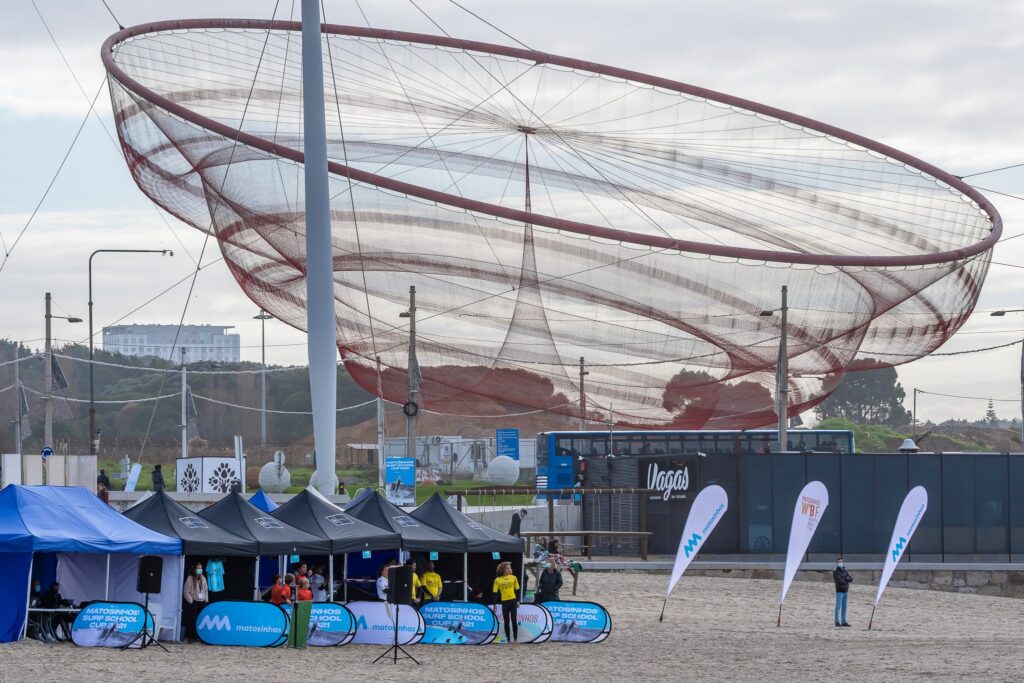
Há ainda um outro contributo que o surf presta a Matosinhos e a toda a sua comunidade, porventura o mais importante: hoje, esta praia conta com a vigilância dos surfistas e das Escolas de Surf nela sediadas, 365 dias por ano. São cada vez mais recorrentes os episódios de salvamentos e resgates praticados por surfistas em toda a parte, porque os surfistas são homens e mulheres do mar, como peixes dentro de água, conhecedores das suas dinâmicas e dos seus perigos, herdeiros de um saber empírico transportado desde os nossos antepassados. É, por isso, essencial apostar na profissionalização desta atividade, potenciando o papel das Escolas de Surf enquanto agentes de formação e educação das gerações futuras, com um contributo inestimável na literacia marítima da população, para que no futuro não tenhamos a lamentar tantas vidas perdidas para o mar.
There is also another contribution that surfing gives to Matosinhos and all its community, perhaps the most important: today, this beach is watched over by surfers and the Surf Schools based there, 365 days a year. There are more and more frequent episodes of rescues and rescues practised by surfers everywhere, because surfers are men and women of the sea, like fish in the water, who know its dynamics and its dangers, heirs of an empirical knowledge carried over from our ancestors. It is therefore essential to invest in the professionalisation of this activity, enhancing the role of surfing schools as agents of training and education for future generations, with an invaluable contribution to maritime literacy among the population, so that in the future we will not have to mourn so many lives lost at sea.
A sul, as ondas mais suaves da Praia de Matosinhos, são ideais para a iniciação. (© Câmara Municipal de Matosinhos).
To the south, the softer waves of Matosinhos Beach are ideal for beginners. (© Matosinhos City Hall).
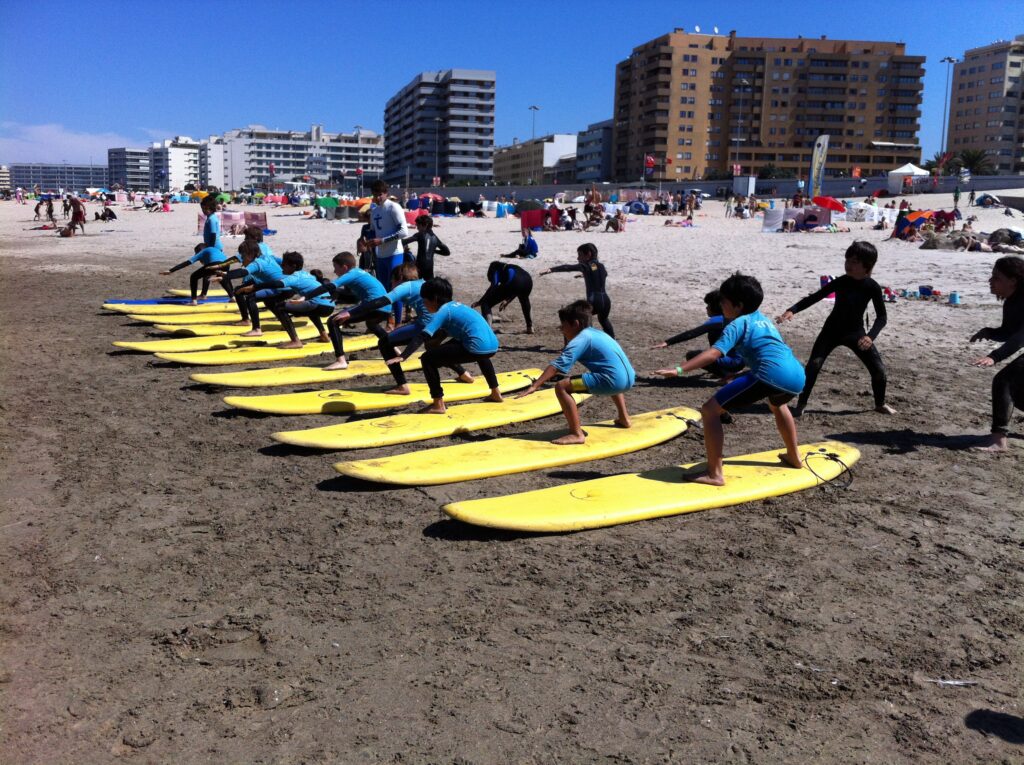
A existência da infraestrutura do porto de Leixões foi determinante na criação de condições excecionais para que a Praia de Matosinhos se afirmasse como uma referência do surf nacional. Contribuiu assim, de forma indireta, para a formação e educação marítima de toda uma comunidade, que vive de e para o mar, tornando as praias mais seguras e, consequentemente, mais prazeroso o usufruto do mar por parte de todos. Hoje, como há dois mil anos atrás, gravita em torno de Leixões uma sabedoria e um conhecimento sobre o mar que deve ser preservado e transmitido de geração em geração.
The existence of the Leixões port infrastructure was crucial in creating exceptional conditions for Matosinhos Beach to establish itself as a national surf reference. It has thus indirectly contributed to the maritime training and education of an entire community, which lives from and for the sea, making the beaches safer and, consequently, more pleasurable the enjoyment of the sea by everyone. Today, as two thousand years ago, there is around Leixões wisdom and knowledge about the sea that must be preserved and transmitted from generation to generation.
Teresa Bonvalot, surfista Olímpica nacional, em Leça da Palmeira. (© Câmara Municipal de Matosinhos).
Teresa Bonvalot, National Olympic surfer, in Leça da Palmeira. (© Matosinhos CIty Hall).
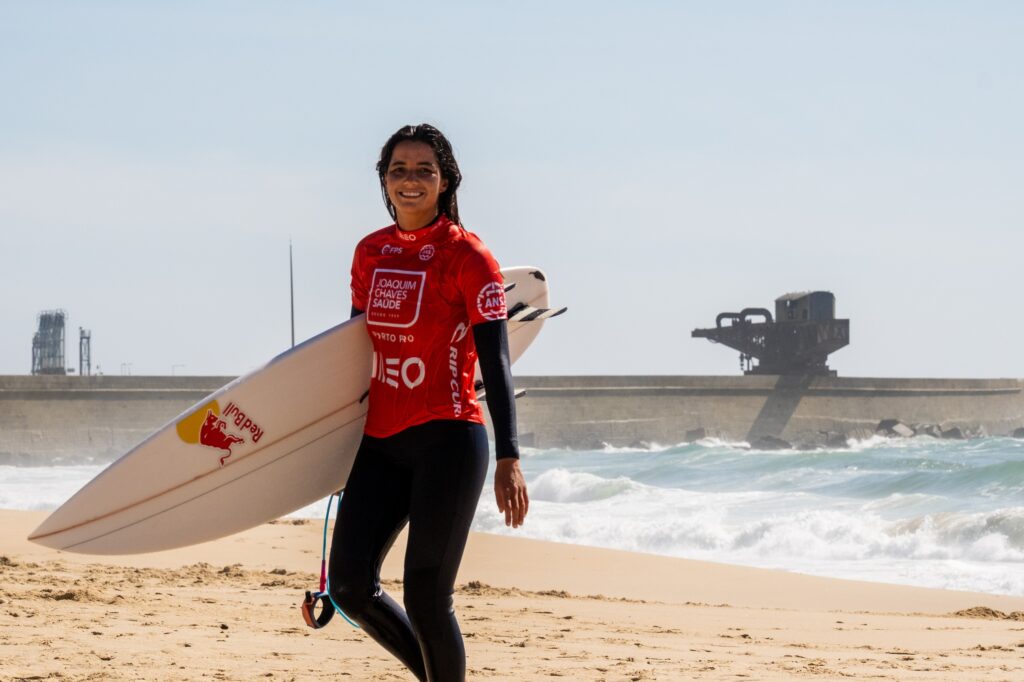
Atleta profissional e esperança nacional, Afonso Antunes, nas ondas de Leça da Palmeira. (© Câmara Municipal de Matosinhos).
Professional athlete and national hope, Afonso Antunes, in the waves of Leça da Palmeira. (© Matosinhos City Hall).
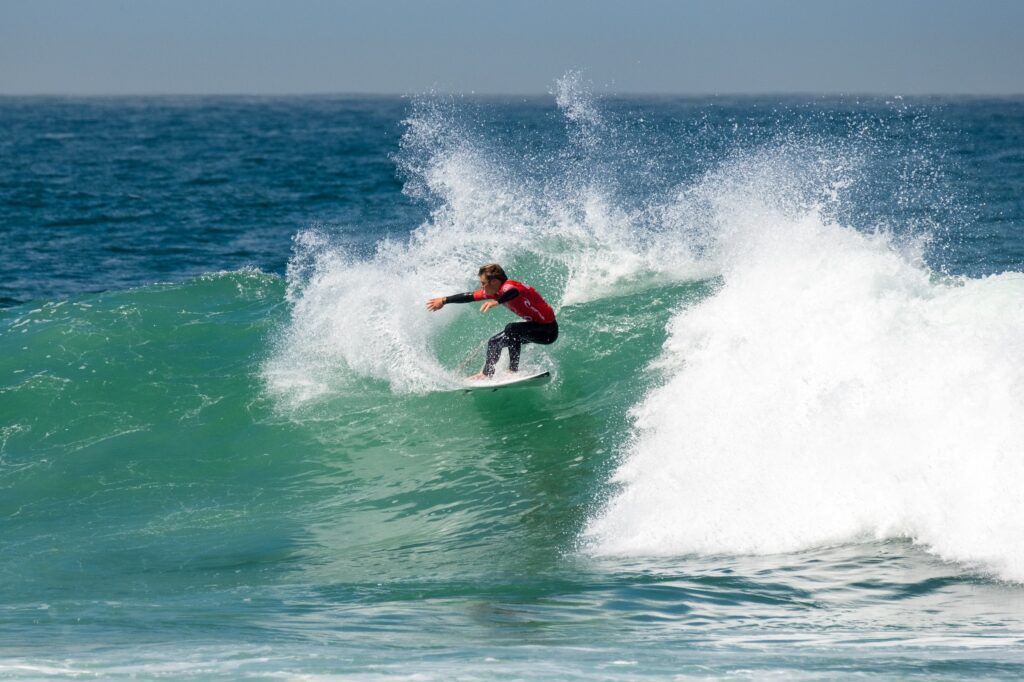
Foi a intervenção humana na costa, com a construção de um porto artificial, que deu à praia de Matosinhos a sua consistência única para a prática de surf. Esta é, efetivamente, uma típica praia de cidade, uma surf city, fortemente urbanizada, que coexiste, numa delicada harmonia, com o exercício de uma atividade de puro contacto com a natureza. No entanto, este equilíbrio harmonioso deve ser cuidadosamente gerido e preservado de uma forma sustentável, para que as gerações futuras possam também usufruir dele. Sendo verdade que é a artificialidade do porto e do quebra-mar de Leixões que permite esta dinâmica tão própria da Praia de Matosinhos, é também inegável que qualquer intervenção costeira pode ter consequências devastadoras para a comunidade de surf. A obra de extensão do quebra-mar atualmente em curso terá certamente impactos na dinâmica da praia e na prática de surf, sendo, por isso, essencial envolver esta comunidade no acompanhamento das consequências sentidas e nos processos de tomada de decisão em intervenções futuras, para que se consiga manter o delicado balanço entre a artificialidade portuária e o seu contributo para a formação de homens e mulheres do mar.
It was human intervention on the coast, with the construction of an artificial harbour, that gave Matosinhos beach its unique consistency for surfing. This is, in fact, a typical city beach, a surf city, strongly urbanized, which coexists, in delicate harmony, with the exercise of an activity of pure contact with nature. However, this harmonious balance must be carefully managed and preserved in a sustainable way, so that future generations may also enjoy it. Being true that it is the artificiality of the port and the breakwater of Leixões that allows this dynamic so proper of the Matosinhos Beach, it is also undeniable that any coastal intervention can have devastating consequences for the surf community. The work to extend the breakwater currently underway will certainly have an impact on the dynamics of the beach and on the practice of surfing, and it is therefore essential to involve this community in the monitoring of the consequences felt and in the decision-making processes in future interventions, so that the delicate balance between the artificiality of the port and its contribution to the training of men and women of the sea can be maintained.
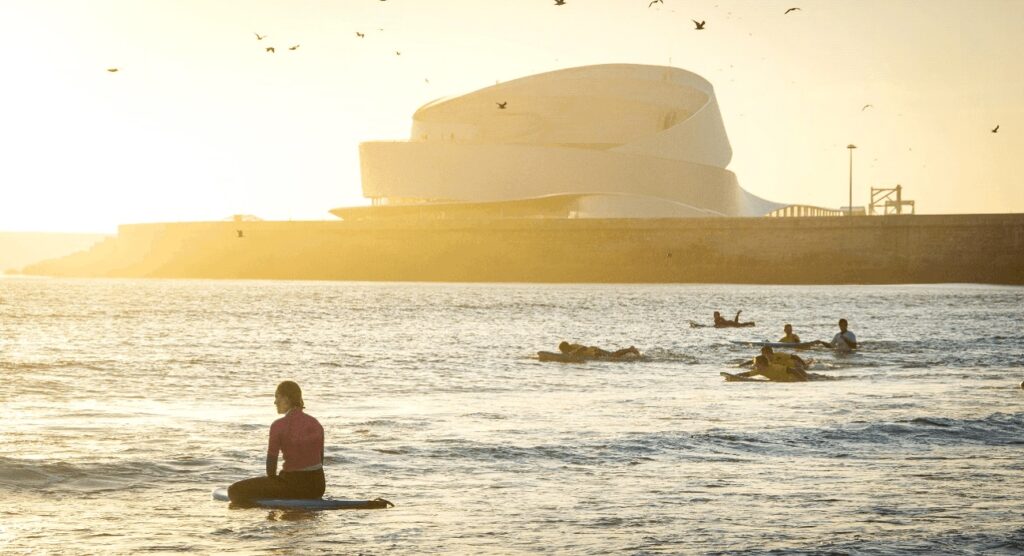
Hora dourada no mar da Praia de Matosinhos, com vista para o porto e terminal de Leixões. (© Onda Pura).
Golden hour in the sea at Matosinhos Beach, overlooking the port and terminal of Leixões. (© Onda Pura).
IMAGEM INICIAL | O Surf do lado norte do Porto de Leixões, nas ondas fortes da praia de Leça da Palmeira. (© Câmara Municipal de Matosinhos).
HEAD IMAGE | Surf on the north side of the Port of Leixões, in the strong waves at Leça da Palmeira beach.(© Matosinhos City Hall).